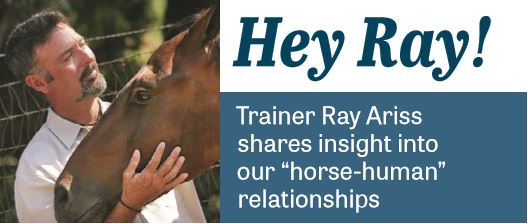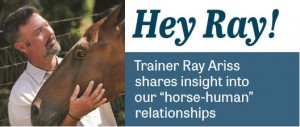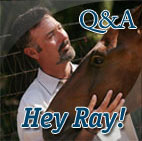Time bomb or bomb-proof? How do I tell?
By Ray Ariss | Horsetrader columnist

HEY RAY! I’m looking to buy a horse and I’m really concerned about ending up with a ticking time bomb when what I need is a bomb-proof horse. Do you have any tips for me or red flags to look out for, since I can’t afford to take a professional with me?
–Karen Hutton, Apple Valley
HEY KAREN: I hate to tell you, but if you hope to end up with the right horse, you can’t afford not to take a professional with you. If you are looking to save a few bucks, you can do most of the running around until you narrow down the list to the two or three favorite horses that should be looked at by your trainer of choice. Believe me when I say, the best money you will ever invest in your horse will be the evaluation given by your professional. Part of that evaluation should include you riding one of the trainer’s lesson horses so that he may get a clear picture of the type and level of rider he will be buying for. The horse that you should see first with your trainer should be the one at the top of the list, and work down from there. That way you might get lucky and end up with your favorite horse and only pay for one pre-purchase evaluation. Here are some suggestions that should facilitate the process in finding your dream horse:
Time bomb or bomb-proof? How do I tell?
Honesty is the only policy when evaluating your horse
 HEY RAY! I recently adopted a 5-year-old Thoroughbred mare off the track. She behaves well except when I put a saddle on. Then she gets antsy and walks on top of me and sometimes rears. But once the saddle is on, she’s fine. How do I get her to stop before she gets too dangerous?
HEY RAY! I recently adopted a 5-year-old Thoroughbred mare off the track. She behaves well except when I put a saddle on. Then she gets antsy and walks on top of me and sometimes rears. But once the saddle is on, she’s fine. How do I get her to stop before she gets too dangerous?
–April Zimmerman, Aguanga, Calif
How can I help my horses get along when they’re eating?
 HEY RAY! How do I approach my mare, Koda, and train her not to bite or kick the heck out of our other horse, Eddie, while eating? –Ryla Haday, Sonora
HEY RAY! How do I approach my mare, Koda, and train her not to bite or kick the heck out of our other horse, Eddie, while eating? –Ryla Haday, Sonora
HEY RYLA: I understand that not taken care of, this problem can result in one or both horses getting hurt—as well as yourself. First, please understand that what Koda and Eddie are going through is absolutely normal and natural. This kind of thing happens with horses all the time.
My colt refuses to trot with me… help!
HEY RAY! I own a big 3-year-old Friesian colt that will not trot next to me when asked. He either drags behind me at the walk or when pushed will erupt into a dead-run—kicking, rearing and playing while dragging me. I’d like to show him in halter, but I’m afraid he’ll get away and hurt himself or someone.
–Jacquelyn Anderson, Fresno
 HEY JACQUELYN: The challenge that you are up against is very common. Once your horse is clear about what is expected and sees the value in it, it won’t matter whether he’s a big colt or an old pony. The first thing we need to do is break your question down into the six individual issues in hand:
HEY JACQUELYN: The challenge that you are up against is very common. Once your horse is clear about what is expected and sees the value in it, it won’t matter whether he’s a big colt or an old pony. The first thing we need to do is break your question down into the six individual issues in hand:
Canter too fast? Make the choice his
 HEY RAY! How do you get a “chargey” Mustang to rate at the canter? Mine does everything well at the walk and trot, just not the canter. —Dennis Parker, Zamora, CA
HEY RAY! How do you get a “chargey” Mustang to rate at the canter? Mine does everything well at the walk and trot, just not the canter. —Dennis Parker, Zamora, CA
HEY DENNIS: The good news is you have 66 percent of your horse under control! I assume you didn’t have a stuck accelerator issue with the other two gaits. If you did, I would simply advise you to use the same approach and technique for the canter. The simplest way to get your horse to understand that racing at the canter is something he can do—but not necessarily a good idea— is to allow him to lunge around you at whatever speed he chooses until he slows down. The keys here are:
A. Be sure you don’t encourage or motivate him to move in any way unless he breaks out of the gait. (This means hands down, quiet and little-or-no foot movement at all.)
B. If and when he breaks, remember to jump start him back into the canter assertively and then back off immediately to a passive state on your part.
Train big—with small successes
Trainer Ray Ariss shares insight into our “horse-human” relationships
 HEY RAY! I was working with my 4-year-old Mustang mare, “Cowgirl,” and tried to get her to go over a “teeter-totter” obstacle. She would walk around it, but as soon as I would try to get her to step onto it, she refused. I tried going over the side of it, and the most she would do is jump it and mess around. I stayed out there for a long time, and it didn’t help. How can I fix this? —Jacky Hare, Silverado, Calif.
HEY RAY! I was working with my 4-year-old Mustang mare, “Cowgirl,” and tried to get her to go over a “teeter-totter” obstacle. She would walk around it, but as soon as I would try to get her to step onto it, she refused. I tried going over the side of it, and the most she would do is jump it and mess around. I stayed out there for a long time, and it didn’t help. How can I fix this? —Jacky Hare, Silverado, Calif.
Freedom of choice is key to your horse’s happiness—and reactions
 HEY RAY! This is about lost trust and resentment. I was training my horse, Connor, for trailering. Whenever he stopped in front of the trailer, I would back him up forcefully—I was trying to make the choice of either going “forward” or being “backed up forcefully.” I had thought of “backing up” as punishment. At that time, I didn’t know about SWAP and didn’t reward him for successfully backing up. Not only that, I backed him up very forcefully. If I caught up to him while I was running forward, he would get a sharp tap in the chest. Now he is resentful. How do I get him back? —Evan Moser, Lancaster, Calif.
HEY RAY! This is about lost trust and resentment. I was training my horse, Connor, for trailering. Whenever he stopped in front of the trailer, I would back him up forcefully—I was trying to make the choice of either going “forward” or being “backed up forcefully.” I had thought of “backing up” as punishment. At that time, I didn’t know about SWAP and didn’t reward him for successfully backing up. Not only that, I backed him up very forcefully. If I caught up to him while I was running forward, he would get a sharp tap in the chest. Now he is resentful. How do I get him back? —Evan Moser, Lancaster, Calif.
Right approach can overcome insecurity, confusion
 HEY RAY! I sent my 5 yr old Thoroughbred gelding to a local trainer for 30 days to put some leg aids on him. Before he left, he didn’t know his leads but I could canter him in both directions with no problems. When I got him back I saw the trainer do leg yields and canter him on the correct leads but he seemed a little on the muscle and worried. I’ve had him at home for a month now and even though he doesn’t fight, he seems to lose his mind anytime I think of using my legs for anything. What happened? Can you help me? —Lisa Martinez, Scottsdale, Ariz
HEY RAY! I sent my 5 yr old Thoroughbred gelding to a local trainer for 30 days to put some leg aids on him. Before he left, he didn’t know his leads but I could canter him in both directions with no problems. When I got him back I saw the trainer do leg yields and canter him on the correct leads but he seemed a little on the muscle and worried. I’ve had him at home for a month now and even though he doesn’t fight, he seems to lose his mind anytime I think of using my legs for anything. What happened? Can you help me? —Lisa Martinez, Scottsdale, Ariz
Q&A – Hey Ray!: Let’s put a halt to confusion about the ‘half-halt’
 HEY RAY! I’ve ridden over 20 years under several trainers, and they all have used a term that I am embarrassed to admit that I don’t know—a “half-halt”. What is this, and how do we apply it? —Anonymous rider, San Diego, Calif
HEY RAY! I’ve ridden over 20 years under several trainers, and they all have used a term that I am embarrassed to admit that I don’t know—a “half-halt”. What is this, and how do we apply it? —Anonymous rider, San Diego, Calif
DEAR A.R.: Your situation is a lot more common than you think. You would be surprised how many riders have confided in me that exact same question over the years. This is a topic that I actually like to explain and talk about. Once you have the right visual, it’s a very helpful and effective tool in helping with balance and self carriage.
When we think of the word halt, the picture we usually see is immobility or “freeze.” The purpose of halting is to bring all movement to a complete stop. A half-halt is exactly the opposite of a halt, but it is not a half-hearted halt or kind of halt. The halfhalt has a very specific purpose—to possibly stop, if necessary as an adjustment, with the intention of continuing to move forward.



 Have a question?
Have a question?
